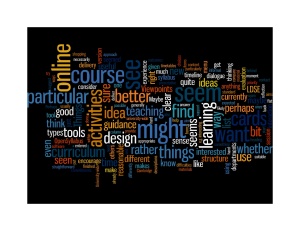About 13Things:
Which Things, or kinds of Thing, or just ideas, did you find most useful, or thought-provoking? Why those ones in particular?
I preferred simple things that structured curriculum design in a non-prescriptive way
Which didn’t you find useful (at all)?
Over-complicated online tools with an implicit (and debatable) agenda
Are there any Things or ideas you think you will use in future?
I already use CamTools and expect to continue to do so.
None that I would see as essential, but Viewpoints and OpenSyllabus seem the most likely
Were any useful enough that they’d be worth mentioning to other colleagues, or promoting or offering more widely in the University?
If there were University-wide momentum for syllabus standardisation then OpenSyllabus would seem the best of the 13 as a starting point.
I might consider suggesting to a new (or indeed an old) colleague to look at Viewpoints if they were wanting some ideas.
About the programme:
Looking back over the programme, what were the good bits about it for you? Ideas, tools, dialogue, reflection, something else?
I was interested to see the tools. Even if they didn’t do anything for me it was interesting to see what is being offered in this area.
I was somewhat disappointed that I didn’t find anything very new, different or particularly exciting, but also reassured, in a way, that there is nothing I am missing out on.
What could have made it better?
Maybe fewer things (a lot to get through 13 with other commitments)
Perhaps more similar things (it seemed a bit of a mix)
There also seemed to be a lack of clarity on what curriculum design is about, how it relates, or not, to syllabus design (I felt that the definition of syllabus given in Thing11 was more what I was expecting than some of the e-learning material). Many of the Things also seemed to relate more to curriculum delivery than curriculum content. The two are related, but the latter is, as I have argued previously, the starting point.
More interaction (I have done almost all of this independently and haven’t had time to track other people’s blogs, so it’s maybe a rather idiosyncratic take on Things)
What do you think of the idea of an informal forum or network, for Cambridge staff interested in teaching and learning ideas? Is there a need? Would it interest you?
I think there is a need. It is hard to innovate on your own and good to learn from others’ experience, but it is difficult to find the time and to coordinate on a University-wide basis. This maybe reflects the general lack of priority to teaching compared to other commitments.
If 13 Things were to continue, in some form, what should that form be?
Perhaps if there were new Things, or updates of ones that we have seen already it would be good to be notified of these. Maybe it would be better, though, if it evolved towards the sort of informal forum/network above.
My Wordle



